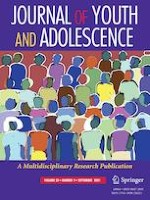22-06-2021 | Empirical Research
The Impact of Childhood Bullying Trajectories on Young Adulthood Antisocial Trajectories
Gepubliceerd in: Journal of Youth and Adolescence | Uitgave 9/2021
Log in om toegang te krijgenAbstract
Long-term outcomes of childhood bullying perpetration have been explored, but heterogeneity in outcomes reflecting nonclinical antisocial tendencies including indirect aggression, psychopathic personality, and interpersonal relations have not been examined from a person-centered approach. Accordingly, latent class growth analyses were used to examine trajectory groups of childhood bullying perpetration across ages 10 to 18 and multi-trajectory groups of young adulthood outcomes across ages 19 to 23 (indirect aggression, psychopathic personality, interpersonal relations). In a sample of 701 participants (52.9% girls/women) followed annually, the majority of individuals reflected a low stable trajectory of bullying (81.2%) and fewer reflected moderate increasing bullying (18.8%). In young adulthood, the majority of participants reflected a prosocial multi-trajectory profile (61.6%; below average decreasing indirect aggression, below average decreasing psychopathy, above average stable interpersonal relations). Fewer participants reflected a below average antisocial profile (21.6%; below average decreasing indirect aggression, below average stable psychopathy, below average stable interpersonal relations) or an above average antisocial profile (16.8%; above average decreasing indirect aggression, above average decreasing psychopathy, below average stable interpersonal relations). Individuals following the moderate bullying trajectory in childhood had a significantly higher odds of following the above average antisocial profile but not the prosocial profile in young adulthood, when contrasted against the below average antisocial profile. These findings indicate that the prevention of childhood bullying can help prevent the continuity of an antisocial profile in young adulthood that is characterized by continued aggressive behavior, higher psychopathy, and poorer quality relationships.
